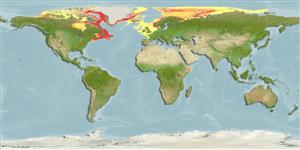Environment: milieu / climate zone / depth range / distribution range
ນິເວດວິທະຍາ
ສັດທະເລ ກ່ຽວກັບ(ຢູ່)ຊັ້ນນ້ຳໃນທະເລທີ່ເໜີອພື້ນດິນ; ລະດັບຄວາມເລິກ 18 - 930 m (Ref. 117245). Deep-water; -1°C - 4°C (Ref. 13534); 83°N - 41°N, 139°W - 141°E (Ref. 117245)
Western Atlantic: western Greenland (Ref. 4695), Hudson Bay and Labrador to Massachusetts (Ref. 7251). Arctic: west of Boothia Peninsula in the Northwest Territories (Ref. 3814) and the northern parts of Kara and Laptev seas (Ref. 4695).
ຂະໜາດ / ນ້ຳໜັກ / Age
Maturity: Lm ? range ? - ? cm
Max length : 36.0 cm TL ຕົວຜູ້/ບໍ່ມີເພດ; (Ref. 7251)
Occurs on soft bottoms (Ref. 13534). Benthic (Ref. 58426). Feeds mainly on epibenthic animals and does not seem to burrow much for prey. Smaller fish prey on smaller species like amphipods, isopods and small bivalves while larger fish prey on shrimps, euphausiids and fish (Ref. 13532).
Life cycle and mating behavior
Maturities | ການສືບພັນ | Spawnings | Egg(s) | Fecundities | ຕົວອ່ອນ
Anderson, M.E., 1994. Systematics and osteology of the Zoarcidae (Teleostei: Perciformes). Ichthyol. Bull. J.L.B. Smith Inst. Ichthyol. 60:120 p. (Ref. 11954)
IUCN Red List Status (Ref. 130435)
Threat to humans
Harmless
Human uses
ເຄື່ອງມື
Special reports
Download XML
ແຫຼ່ງອີນເຕີເນັດ
Estimates based on models
Preferred temperature (Ref.
123201): 1.4 - 7.1, mean 3.5 °C (based on 213 cells).
Phylogenetic diversity index (Ref.
82804): PD
50 = 0.5000 [Uniqueness, from 0.5 = low to 2.0 = high].
Bayesian length-weight: a=0.00309 (0.00192 - 0.00496), b=3.21 (3.07 - 3.35), in cm total length, based on LWR estimates for this species & Genus-body shape (Ref.
93245).
ຊັ້ນເຂດຮ້ອນ (Ref.
69278): 3.5 ±0.53 se; based on food items.
ຄວາມຢືດຢຸ່ນ (Ref.
120179): ຕຳ່, ປະຊາກອນຕຳ່ສຸດທີ່ໃຊ້ເວລາສອງເທົ່າ 4.5 - 14 ປີ (Preliminary K or Fecundity.).
Fishing Vulnerability (Ref.
59153): Low to moderate vulnerability (26 of 100).
